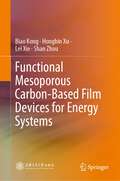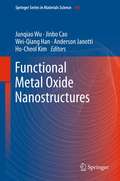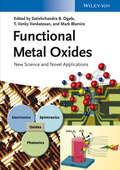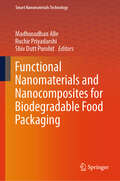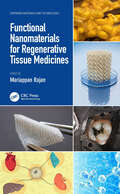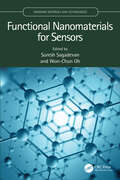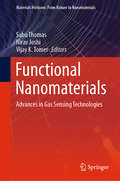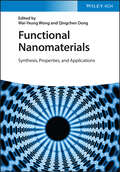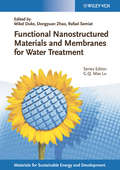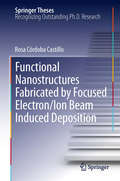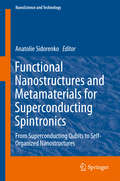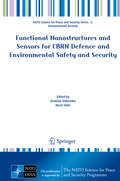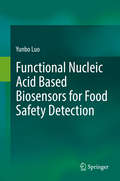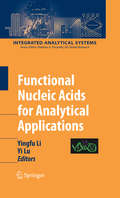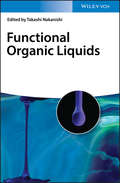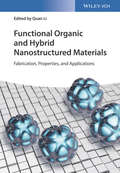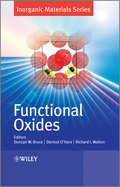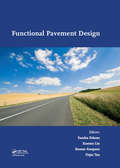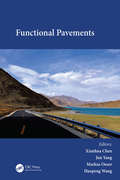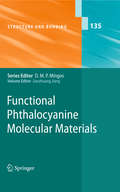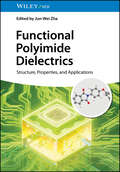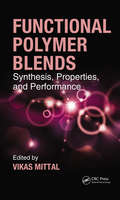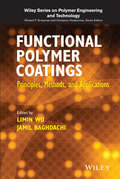- Table View
- List View
Functional Mesoporous Carbon-Based Film Devices for Energy Systems
by Lei Xie Biao Kong Hongbin Xu Shan ZhouThis book introduces the synthesis of functional mesoporous carbon-based films and their applications in energy systems. In the last decades, the consumption of fossil fuels has led to many problems such as the energy crisis and climate change. The rapidly increasing energy demands and environmental issues have attracted lots of attention to develop new functional materials for sustainable energy technology. Mesoporous carbon-based films show unique properties and have been regarded as a promising material applied in highly efficient energy storage and conversion systems. Interfacial assembly strategies are usually employed to construct such film devices. In this book, recent developments in synthesis of mesoporous carbon-based film devices through interfacial assembly strategies are illustrated. Additionally, the applications of mesoporous carbon-based film devices for electrochemical energy systems including batteries and electrocatalysis are introduced to demonstrate their potential, as well as describing the mechanisms to enhance the performance of these systems. Finally, some challenges and future outlooks are presented to inspire better development and contributions to this field in coming years. Given its scope, this book appeals to undergraduate students, graduate students, engineers, and researchers involved in related fields.
Functional Metal Oxide Nanostructures
by Junqiao Wu Jinbo Cao Wei-Qiang Han Ho-Cheol Kim Anderson JanottiMetal oxides and particularly their nanostructures have emerged as animportant class of materials with a rich spectrum of properties and greatpotential for device applications. In this book, contributions from leadingexperts emphasize basic physical properties, synthesis and processing, and thelatest applications in such areas as energy, catalysis and data storage. Functional Metal Oxide Nanostructuresis an essential reference for any materials scientist or engineer with aninterest in metal oxides, and particularly in recent progress in defectphysics, strain effects, solution-based synthesis, ionic conduction, and theirapplications.
Functional Metal Oxides
by T. Venky Venkatesan Satishchandra Balkrishna Ogale Mark BlamireThis forward-looking title focuses on the key innovations for industrial growth areas for functional metal oxides: energy technology, semiconductors, electronics, and automotive.Bridging the gap between basic science and technological applications, the book covers the full range of topics in the field of advanced metal oxide science and technology such as metallic, semiconducting, insulating, ferromagnetic, superconducting, ferroelectric, and multiferroic metal oxide systems and their engineered interface systems. It emphasizes many of the modern applications of metal oxides in solar cells, batteries, catalysis and for resistive switches. Chapters about the growth and processing of oxidic thin films and nanomaterials round the topic out.
Functional Morphology of Feeding and Grooming in Crustacea
by Bruce E. Felgenhauer Anne. B Thistle L. WatlingAbetted by recent technological advances in scanning and transmission electron microscopy, as well as new preparative methods, these contributions examine crustacean anatomy, demonstrating (or at least inferring) the functions of morphological features. In addition to feeding and grooming, they also
Functional Nanomaterials and Devices for Electronics, Sensors and Energy Harvesting
by Francis Balestra Alexei Nazarov Valeriya Kilchytska Denis FlandreThis book contains reviews of recent experimental and theoretical results related to nanomaterials. It focuses on novel functional materials and nanostructures in combination with silicon on insulator (SOI) devices, as well as on the physics of new devices and sensors, nanostructured materials and nano scaled device characterization. Special attention is paid to fabrication and properties of modern low-power, high-performance, miniaturized, portable sensors in a wide range of applications such as telecommunications, radiation control, biomedical instrumentation and chemical analysis. In this book, new approaches exploiting nanotechnologies (such as UTBB FD SOI, Fin FETs, nanowires, graphene or carbon nanotubes on dielectric) to pave a way between "More Moore" and "More than Moore" are considered, in order to create different kinds of sensors and devices which will consume less electrical power, be more portable and totally compatible with modern microelectronics products.
Functional Nanomaterials and Nanocomposites for Biodegradable Food Packaging (Smart Nanomaterials Technology)
by Madhusudhan Alle Shiv Dutt Purohit Ruchir PriyadarshiThis book covers the recent developments in biopolymer nanocomposite materials and their possible impact on the food packaging industry. The food industry has been one of the highest consumers of plastics for the past two decades, where plastics have been used in huge amounts as food packaging materials. The generation of non-biodegradable plastic-based municipal solid waste, especially due to food packaging industry, has now become one of the two paramount problems faced by the world today. The other problem is being the wastage of food in humongous quantities annually. With the onset of globalization, food produced in one part of the world became available to people living in another part. However, during transportation and storage, a plethora of food gets wasted due to microbial contamination of chemical oxidation. This book looks into biopolymer nanocomposites, and it’s the ability to address both these issues. It presents the very essence of biopolymer nanocomposite technology with the combination of various nanomaterials and biopolymer to yield a functional product for food packaging, which is demonstrated in the various chapters. In general, this book caters to the needs of students involved in nanotechnology, biotechnology, food technology, industrial chemistry, and many others other interdisciplinary subjects.
Functional Nanomaterials for Regenerative Tissue Medicines (Emerging Materials and Technologies)
by Mariappan RajanThis book covers nanomaterials in tissue engineering for regenerative therapies of heart, skin, eye, skeletal muscle, and the nervous system. The book emphasizes fundamental design concepts and emerging forms of nanomaterials in soft- and hard-tissue engineering. FEATURES Fills a gap in the literature related to the application of nanomaterials in hard- and soft-tissue regeneration, repair, and restructure Discusses a variety of applications, including cardiac, kidney, liver, bone, wound healing, artificial organs, and dental Presents advantages and limitations of various nanomaterials alongside future challenges Functional Nanomaterials for Regenerative Tissue Medicines is essential for academics and industry professionals working in tissue engineering, biomedicine, biopharmaceuticals, and nanotechnology. It is primarily intended for materials researchers (to develop the platforms related to tissue regeneration) as well as clinicians (to learn and apply nanomaterials in their practice) and industrial scientists (to develop commercial blood substitute products).
Functional Nanomaterials for Sensors (Emerging Materials and Technologies)
by Suresh Sagadevan Won-Chun OhBecause of their novel chemical and physical properties, functional nanomaterials have found increasing industrial applications in nanoelectronics, energy science, and biological applications. Functional Nanomaterials for Sensors surveys advances in functional nanomaterials and their use in sensing. It covers their properties, synthesis, design, fabrication, and their applications, including in chemical, biological, and gas sensing, environmental remediation, fuel cells, catalysis, electronic devices, and biotechnology. FEATURES: • Describes how nanomaterial functionalization is being used to create more effective sensors • Discusses various synthesis procedures, characterization techniques, and which nanomaterials should be used for sensing applications • Provides an in-depth look into oxide nanostructures, carbon nanostructures, and two-dimensional (2D) material fabrication • Explores the challenges of using nanoscale sensors for large-scale industrial applications This book is aimed at materials, chemical, biotech, and electronics researchers and industry professionals working on sensor design and development.
Functional Nanomaterials: Advances in Gas Sensing Technologies (Materials Horizons: From Nature to Nanomaterials)
by Sabu Thomas Nirav Joshi Vijay K. TomerThis book provides a comprehensive overview of the current state-of-art in oxide nanostructures, carbon nanostructures and 2D materials fabrication. It covers mimicking of sensing mechanisms and applications in gas sensors. It focuses on gas sensors based on functional nanostructured materials, especially related to issues of sensitivity, selectivity, and temperature dependency for sensors. It covers synthesis, properties, and current gas sensing tools and discusses the necessity for miniaturized sensors. This book will be of use to senior undergraduate and graduate students, professionals, and researchers in the field of solid-state physics, materials science, surface science and chemical engineering.
Functional Nanomaterials: Synthesis, Properties, and Applications
by Wai-Yeung Wong Qingchen DongPresents the most recent advances in the production and application of various functional nanomaterials As new synthetic methods, characterization technologies, and nanomaterials (NMs) with novel physical and chemical properties are developed, researchers and scientists across disciplines need to keep pace with advancements in the dynamic field. Functional Nanomaterials: Synthesis, Properties and Applications provides comprehensive coverage of fundamental concepts, synthetic methods, characterization technologies, device fabrication, performance evaluation, and both current and emerging applications. Contributions from leading scientists in academia and industry present research developments of novel functional nanomaterials including metal nanoparticles, two-dimensional nanomaterials, perovskite-based nanomaterials, and polymer-based nanomaterials and nanocomposites. Topics include metal-based nanomaterials for electrochemical water splitting, cerium-based nanostructure materials for electrocatalysis, applications of rare earth luminescent nanomaterials, metal complex nanosheets, and methods for synthesizing polymer nanocomposites. Provides readers with timely and accurate information on the development of functional nanomaterials in nanoscience and nanotechnology Presents a critical perspective of the design strategy, synthesis, and characterization of advanced functional nanomaterials Focuses on recent research developments in emerging areas with emphasis on fundamental concepts and applications Explores functional nanomaterials for applications in areas such as electrocatalysis, bioengineering, optoelectronics, and electrochemistry Covers a diverse range of nanomaterials, including carbonaceous nanomaterials, metal-based nanomaterials, transition metal dichalcogenides-based nanomaterials, semiconducting molecules, and magnetic nanoparticlesFunctional Nanomaterials: Synthesis, Properties and Applications is an invaluable resource for chemists, materials scientists, electronics engineers, bioengineers, and others in the scientific community working with nanomaterials in the fields of energy, electronics, and biomedicine.
Functional Nanostructured Materials and Membranes for Water Treatment
by Max Lu Dongyuan Zhao Mikel Duke Rafael SemiatMembranes have emerged over the last 30 years as a viable water treatment technology. Earth's population is growing and the need for alternative ways to generate potable water is rising. The recent advent of nanotechnology opens the door to improving processes in membranetechnology, which is a promising step on the way to solving the earth's potable water problem. Current performance is enhanced and new concepts are possible by engineering on the nanoscale. This book presents key areas of nanotechnology such as fouling tolerant and robust membranes, enhanced destruction of pollutants and faster monitoring of water quality.'Functional Nanostructured Materials and Membranes for Water Treatment' is part of the series on Materials for Sustainable Energy and Development edited by Prof. G.Q. Max Lu. The series covers advances in materials science and innovation for renewable energy, clean use of fossil energy, and greenhouse gas mitigation and associated environmental technologies.
Functional Nanostructures Fabricated by Focused Electron/Ion Beam Induced Deposition
by Rosa Córdoba CastilloThis thesis constitutes a detailed study of functional nanostructures (ferromagnetic, superconducting, metallic and semiconducting) fabricated by focused electron/ion beam induced deposition techniques. The nanostructures were grown using different precursor materials such as Co2(CO)8, Fe2(CO)9, W(CO)6, (CH3)3Pt(CpCH3) and were characterized by a wide range of techniques. This work reports results obtained for the morphology, the microstructure, the composition, the electrical transport mechanism, magnetic and superconducting properties of nanostructures. The results offers exciting prospects in a wide range of applications in nanotechnology and condensed matter physics.
Functional Nanostructures and Metamaterials for Superconducting Spintronics: From Superconducting Qubits to Self-Organized Nanostructures (NanoScience and Technology)
by Anatolie SidorenkoThis book demonstrates how the new phenomena in the nanometer scale serve as the basis for the invention and development of novel nanoelectronic devices and how they are used for engineering nanostructures and metamaterials with unusual properties. It discusses topics such as superconducting spin-valve effect and thermal spin transport, which are important for developing spintronics; fabrication of nanostructures from antagonistic materials like ferromagnets and superconductors, which lead to a novel non-conventional FFLO-superconducting state; calculations of functional nanostructures with an exotic triplet superconductivity, which are the basis for novel nanoelectronic devices, such as superconducting spin valve, thin-film superconducting quantum interference devices (SQUIDs) and memory-elements (MRAM). Starting with theoretical chapters about triplet superconductivity, the book then introduces new ideas and approaches in the fundamentals of superconducting electronics. It presents various quantum devices based on the new theoretical approaches, demonstrating the enormous potential of the electronics of 21st century - spintronics. The book is useful for a broad audience, including researchers, engineers, PhD graduates, students and others wanting to gain insights into the frontiers of nanoscience.
Functional Nanostructures and Sensors for CBRN Defence and Environmental Safety and Security (NATO Science for Peace and Security Series C: Environmental Security)
by Anatolie Sidorenko Horst HahnOver the last decade, techniques for materials preparation and processing at nanometer scale have advanced rapidly, leading to the introduction of novel principles for a new generation of sensors and detectors. At the same time, the chemical industry, transport and agriculture produce huge amounts of dangerous waste gases and liquids, leading to soil, air and water contamination. One more modern threat - international terrorism - demands that scientists make efforts to apply new principles and technologies to protect society against chemical, biological, radiological and nuclear (CBRN) attacks and to develop novel effective technologies for the remediation of large contaminated areas. Accordingly, the main goal of this book is to bring together experts (theorists, experimentalists, engineers and technologists) for an extensive discussion covering: novel principles for functional nanostructures and detector fabrication and implementation, the development of novel technologies for the deactivation of CBRN agents, their experimental realization and their application in novel monitoring and control systems, and technological processes for soil and water remediation, with a view to environmental protection and defence against CBRN-based terrorism. In keeping with the book’s main goal, the following topics are highlighted and discussed: - Sensors and detectors - detection of chemicals, principles of “artificial nose” and chemical “micro-lab on a chip” design, surface and underground water quality monitoring systems, molecular electronics, superconducting electronic devices, quantum detectors and Qubits. - Environmental protection and CBRN - detection of infrared, microwave, X-ray and terahertz radiation. Principles for novel IR-, UV-, and Terahertz-wave devices for the detection of low-contrast objects. - Novel technological processes for CBRN destruction and deactivation. All these topics are strongly interrelated, both with regard to fundamental aspects and to fabrication and implementation technologies; in addition, they are highly promising for application in novel functional devices, computer logics, sensing and detection of low-concentration chemicals, weak and extremely weak magnetic and microwave fields, infrared and ultraviolet radiation. Given its scope, the book will be a useful and interesting guide for a broad readership of engineers, scientists, PhD students and experts in the area of defence against environmental terrorism.
Functional Nucleic Acid Based Biosensors for Food Safety Detection
by Yunbo LuoThis book highlights the development of a functional nucleic acid based biosensor detection method in the context of food safety. Although there have been major advances in food processing technology in both developed and developing countries, food safety assurance systems are generally becoming more stringent, in response to growing (both real and perceived) food safety problems. These problems are due in part to foodborne microorganisms, heavy metals, and small chemical molecules (biological toxins, pesticide residues, and veterinary drug residues), etc. In addition, the nucleic acid biomarkers (DNA methylation, microRNA, and circRNA) induced by these risk factors are also closely related to food safety. Accordingly, this book offers a brief guide to targets and strategies in functional nucleic acid based biosensors for food safety detection. Divided into several chapters that focus on various respective targets, it will be a valuable resource for students and researchers in the fields of biosensor detection, food science etc.
Functional Nucleic Acids for Analytical Applications
by Yi Lu Yingfu LiNature has long used nucleic acid aptamers and enzymes for regulatory activities, such as the recently discovered "riboswitches" involved in gene expression. The existence of a large array of natural and artificial functional nucleic acids has generated tremendous enthusiasm and new opportunities for molecular scientists from diverse disciplines to devise new concepts and real applications that take advantage of those nucleic acids for sensing and other analytical applications. This book provides a timely and comprehensive overview of recent advances in the field, from leading experts in biology, chemistry, and engineering. A variety of topics are covered, from fundamentals of functional nucleic acids, to their applications as sensors, to nanotechnologies; as well as integration of functional nucleic acids into practical analytical systems.
Functional Organic Liquids
by Takashi NakanishiThe first book to comprehensively cover the burgeoning new class of soft materials known as functional organic liquids Functional organic liquids, a new concept in soft matter materials science, exhibit favorable properties compared to amorphous polymers and ionic liquids. They are composed of a functional core unit and a side chain, which induces fluidity even at room temperature. Due to their fluidity, functional organic liquids can adopt any shape and geometry and fulfill their function in stretchable and bendable devices for applications in photovoltaics, organic electronics, biomedicine, and biochemistry. Presented in five parts, this book starts with an overview of the design methods and properties of functional organic liquids. The next three parts focus on the applications of this exciting new class of soft materials in the fields of energy conversion, nanotechnology, and biomaterials. They study the liquids for energy conversion, those containing inorganic nanoclusters, and solvent-free soft biomaterials. Functional Organic Liquids concludes with a comparison in terms of properties and application potential between functional organic liquids and more conventional soft matter such as ionic liquids and liquid metals. -Examines the current state of science and technology for functional organic liquids -Focuses on potential and already realized applications such as functional organic liquids for energy conversion -Stimulates researchers to move forward on future development and applications Functional Organic Liquids is an excellent book for materials scientists, polymer chemists, organic chemists, physical chemists, surface chemists, and surface physicists.
Functional Organic and Hybrid Nanostructured Materials: Fabrication, Properties, and Applications
by Quan LiThe first book to explore the potential of tunable functionalities in organic and hybrid nanostructured materials in a unified manner. The highly experienced editor and a team of leading experts review the promising and enabling aspects of this exciting materials class, covering the design, synthesis and/or fabrication, properties and applications. The broad topical scope includes organic polymers, liquid crystals, gels, stimuli-responsive surfaces, hybrid membranes, metallic, semiconducting and carbon nanomaterials, thermoelectric materials, metal-organic frameworks, luminescent and photochromic materials, and chiral and self-healing materials.
Functional Oxides
by Dermot O'Hare Richard I. Walton Duncan W. BruceFunctional oxides have a wide variety of applications in the electronic industry. The discovery of new metal oxides with interesting and useful properties continues to drive much research in chemistry, physics, and materials science.In Functional Oxides five topical areas have been selected to illustrate the importance of metal oxides in modern materials chemistry:Noncentrosymmetric Inorganic Oxide MaterialsGeometrically Frustrated Magnetic MaterialsLithium Ion Conduction in OxidesThermoelectric OxidesTransition Metal Oxides - Magnetoresistance and Half-MetallicityThe contents highlight structural chemistry, magnetic and electronic properties, ionic conduction and other emerging areas of importance, such as thermoelectricity and spintronics.Functional Oxides covers these complex concepts in a clear and accessible manner providing an excellent introduction to this broad subject area.
Functional Pavement Design: Proceedings of the 4th Chinese-European Workshop on Functional Pavement Design (4th CEW 2016, Delft, The Netherlands, 29 June - 1 July 2016)
by Sandra Erkens; Xueyan Liu; Kumar Anupam; Yiqiu TanFunctional Pavement Design is a collections of 186 papers from 27 different countries, which were presented at the 4th Chinese-European Workshops (CEW) on Functional Pavement Design (Delft, the Netherlands, 29 June-1 July 2016). The focus of the CEW series is on field tests, laboratory test methods and advanced analysis techniques, and cover analysis, material development and production, experimental characterization, design and construction of pavements. The main areas covered by the book include: - Flexible pavements- Pavement and bitumen- Pavement performance and LCCA- Pavement structures- Pavements and environment- Pavements and innovation- Rigid pavements- Safety- Traffic engineering Functional Pavement Design is for contributing to the establishment of a new generation of pavement design methodologies in which rational mechanics principles, advanced constitutive models and advanced material characterization techniques shall constitute the backbone of the design process. The book will be much of interest to professionals and academics in pavement engineering and related disciplines.
Functional Pavements: Proceedings of the 6th Chinese–European Workshop on Functional Pavement Design (CEW 2020), Nanjing, China, 18-21 October 2020
by Xianhua ChenFunctional Pavements is a collection of papers presented at the 6th Chinese-European Workshop (CEW) on Functional Pavement Design (Nanjing, China, October 18-21, 2020). The focus of the CEW series is on field tests, laboratory test methods and advanced analysis techniques, and cover analysis, material development and production, experimental characterization, design and construction of pavements. The main areas covered by the book include: • Asphalt binders for flexible pavements• Asphalt mixture evaluation and performance• Pavement construction and maintenance• Pavement Surface Properties and Vehicle Interaction• Cementitious materials for rigid pavements• Pavement geotechnics and environment Functional Pavements aims at contributing to the establishment of a new generation of pavement design methodologies in which rational mechanics principles, advanced constitutive models and advanced material characterization techniques shall constitute the backbone of the design process. The book will be much of interest to professionals, academics and practitioners in pavement engineering and related disciplines as it should assist them in providing improved road pavement infrastructure to their stakeholders.
Functional Phthalocyanine Molecular Materials
by Jianzhuang Jiang*This series presents critical reviews of the present position and future trends in modern chemical research concerned with chemical structure and bonding *Short and concise reports, each written by the worlds renowned experts *Still valid and useful after 5 or 10 years *More information as well as the electronic version of the whole content available at: springerlink. com Content Level Professional/practitioner
Functional Polyimide Dielectrics: Structure, Properties, and Applications
by Jun-Wei ZhaAn of-the-moment discussion of the most cutting-edge research in the field of polyimide dielectrics In Functional Polyimide Dielectrics: Structure, Properties, and Applications, distinguished researcher Dr. Jun-Wei Zha delivers an up-to-date and authoritative discussion of the latest advancements in the application of polyimide dielectrics (PIDs) in electrical and electronic equipment. Readers will find coverage of the application of PIDs in aerospace, high-temperature energy storage capacitors, corona-resistant motors, new energy power equipment, packaging, and more. The book serves as a valuable reference for improving the performance and expanding the application of existing PIDs, as well as designing and developing new PIDs. It also provides a current overview of research and frontier applications that will prove useful to students and researchers from multiple disciplines. Functional Polyimide Dielectrics also contains: A thorough introduction to the different types of polyimide dielectrics, including their synthesis, composites & blends, processing-property relationships, processing strategies and technologies, properties and applicationsComprehensive explorations of a wide range of PID applications in a variety of special applications, like energy storage, insulation, thermal conductivity, intelligence, and morePractical discussions of the environmental aspects of the technology, as well as life cycle assessment sustainable alternative possibilitiesComplete treatments of smart polyimide dielectrics Perfect for materials scientists, electronics engineers, polymer chemists, physicists, and mechanical engineers, Functional Polyimide Dielectrics: Structure, Properties, and Applications will also benefit professionals, engineers, and scientists working in the chemical industry.
Functional Polymer Blends: Synthesis, Properties, and Performance
by Vikas MittalWith their broad range of properties, polymer blends are widely used in adhesion, colloidal stability, the design of composite and biocompatible materials, and other areas. As the science and technology of polymer blends advances, an increasing number of polymer blend systems and applications continue to be developed. Functional Polymer Blends: Syn
Functional Polymer Coatings
by Limin Wu Jamil BaghdachiFocusing on a variety of coatings, this book provides detailed discussion on preparation, novel techniques, recent developments, and design theories to present the advantages of each function and provide the tools for better product performance and properties. * Presents advantages and benefits of properties and applications of the novel coating types * Includes chapters on specific and novel coatings, like nanocomposite, surface wettability tunable, stimuli-responsive, anti-fouling, antibacterial, self-healing, and structural coloring * Provides detailed discussion on recent developments in the field as well as current and future perspectives * Acts as a guide for polymer and materials researchers in optimizing polymer coating properties and increasing product performance
